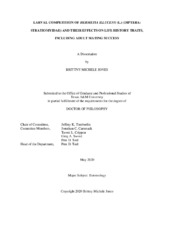| dc.description.abstract | Ephemeral resources are a nutritious source, distributed randomly (temporally and spatially), and promote species diversity. Larval aggregations on ephemeral resources are common within dipteran species and typically lead to interspecific and intraspecific competition. This study aimed to investigate intraspecific competition (i.e., larval competition) and their effects on the life history traits and mating success of the black soldier fly Hermetia illucens, (L.) Diptera: Stratiomyidae. Previous studies have not thoroughly investigated intraspecific competition of H. illucens and their life history traits on an industrial scale. Also, knowledge of egg production from different sized black soldier fly adults have been limited. In this study, the first objective was to determine if different larval population densities yielded significant results. The next objective was to validate if color influenced mate choice. The last objective was to determine if large and small adults differed in successful matings and egg production. For the first objective, the lowest larval density of 500 larvae/4L produced larger adults compared to the highest larval density of 2000 larvae/4L. In addition, low larval densities were significantly different in development time and size across all life stages compared to the highest larval density. In the second objective of the validation study, marking techniques of four various colors did not affect mate choice of marked individuals. Finally, large male adults displayed the most mating successes and level of aggression compared to small males. Large females produced more eggs, but hatch rate slightly decreases. The variability of egg production was prominent in mixed-sized adult treatments compared to large adult treatments only, indicating that such variability could result from various other factors such as size differences and mixed ages. Such information is valuable to the mass production industry of H. illucens in order to predict egg viability output with each generation. | en |


